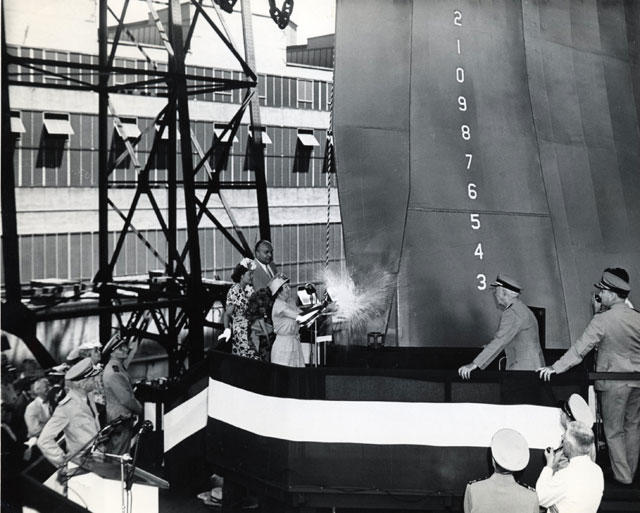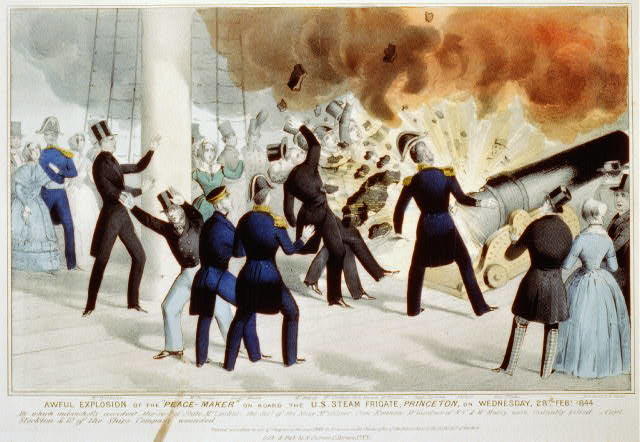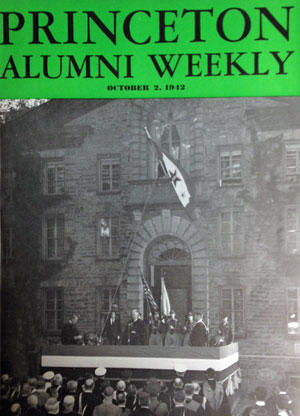Most Holy spirit! Who didst brood
Upon the chaos dark and rude,
And bid its angry tumult cease,
And give, for wild confusion, peace;
Oh, hear us when we cry to Thee
For those in peril on the sea!
— The Navy Hymn, William Whiting, 1860
On Oct. 18, 1942, Margaret Dodds journeyed the 50 miles from Princeton to the dockyard of the New York Shipbuilding Co. in Camden. There the wife of University President Harold Willis Dodds *1914 launched the USS Princeton, the fourth American naval vessel to carry the name. Significant to the era and the ship’s fate, she was the first of them to be an aircraft carrier. The New York Times enthusiastically covered the event.
The age-old superstitions regarding women and the sea are a bit startling when extended to the vast industrial scale of modern warfare (oxymoron alert). The pervasive practice of referring to virtually any watercraft as “she” has been attributed to everything from linguistics to sailors’ yearnings for home and hearth, but still is observed fastidiously around the world today. In the United States, the sponsor of a new ship (ironically, a product of those underliberated folks in Congress and the Pentagon) is virtually always a woman; she is thereafter a talisman of the vessel and its crew, and an honored VIP wherever its men (people, in modern times) gather, celebrate, and remember their time at sea.
It’s a fair bet that this was not topmost on Margaret Murray’s mind at age 26 when she chose in 1917 to marry newly minted politics Ph.D. Harold W. Dodds. We all get surprises out of our marriages, it’s true, but she certainly deserved extra points for her unforeseen destiny as a college president’s wife: While the Depression, World War II, and Korea swirled beyond the campus, she lived for 24 years at Prospect, surrounded by a couple of thousand crazy undergraduates; many of them during wartime were soldiers and sailors. Having to support her husband through this, not to mention running an infinite number of ladies’ teas as campus hostess and guiding spirit of the University League (then a sort of faculty wives’ welcome wagon and self-protection group), would be plenty even without getting involved with the Navy and its long-standing, and somewhat choppy, relationship with ships called Princeton.
All the way back to the first USS Princeton, launched in 1842, the name – actually that of the 1777 Battle of Princeton, not the town or the college – developed some sinister baggage. Robert F. Stockton 1813 (of the Princeton Stocktons from Morven), a captain in the Navy, talked Congress into building a state-of-the-art corvette, promptly named the Princeton, with himself as captain. Its sexy trappings included the world’s largest naval weapon, a cannon very European on the outside and very shoddy on the inside. After being rushed into action, the 13-ton monster was demonstrated for a VIP party on the Potomac on Feb. 28, 1844. It blew apart, killing eight people, including – unbelievably – Secretary of State Abel Upshur 1807, who had been expelled from Princeton three months short of graduation after the Riot of 1807. President John Tyler and James Madison 1771’s widow, Dolley, were spared by virtue of being below decks for drinks.
The reputations of Stockton and the ship never really recovered, and when rotten beams were discovered, she was dismantled in 1849. Her modern engines were used as the core of a new Princeton, and the steam clipper sailed grandly down the Chesapeake in November 1852 on her way with Commodore Matthew Perry to open Japan. Her boiler immediately failed, and she put in at Norfolk, abandoned by Perry and accomplishing very little before being sold in 1866. The third Princeton was launched in 1897 in advance of the country’s emergence onto the world stage; the alumni of the University presented her with a ceremonial bell. Thankfully, the steel gunboat had a comparatively exemplary career patrolling the Caribbean in the Spanish-American War and the Pacific during the Philippine-American War, and was sold in 1919 after the War to End All Wars.
But there have been dangers aboard the most modern Princeton (number six) as well. The current guided-missile cruiser, launched just 25 years ago, was severely damaged by a mine in the Persian Gulf during Operation Desert Storm in February 1991; fortunately, only three seamen were injured. In 2005 she lost a seaman overboard, who was never recovered. She performed well in Operation Desert Storm, however, and during her subsequent current service with the Pacific Fleet. Her immediate predecessor, from 1945-1971, was the most successful vessel carrying the name Princeton; heavily decorated in both Korea and Vietnam, the carrier’s long service in the Pacific was capped by her farewell tour as the primary recovery ship for the Apollo 10 space mission in May 1969.
But Princeton number four, launched an even century after her original predecessor by Mrs. Dodds, was the ship that brought the disastrous explosion on the Potomac back to mind, and worse. Built to fight the Japanese for superiority in the Pacific, she did just that, and put in two successful grueling campaigns, including the great Battle of the Philippine Sea in June of 1944. Six months later came its successor, the ultimate Pacific naval battle, the largest ever seen on earth: the Battle of Leyte Gulf. Fought in large part by opposing ships that could not see one another, air power was critical, and Princeton and her sister carriers were the key to the struggle. After launching numerous flights of planes from her deck, the ship was the victim of a single Japanese dive-bomber that slipped through the American air net. Its single 500-pound bomb exploded below decks; when the ship’s sprinklers failed to function, fires and then secondary explosions rocked the entire structure. Heroic rescue efforts, most notably by the cruiser USS Birmingham, saved hundreds of the thousand-man crew, but in the end a huge explosion of the carrier’s rear magazine disabled her for good and caused huge casualties on the Birmingham as well. In the conflagration, 108 of the carrier’s crew and 233 of the cruiser’s died before the Princeton was scuttled; it was the only U.S. carrier sunk in the last three years of World War II, and the last one to this day. In memoriam, the tattered American flag from the USS Princeton IV now hangs in the south transept of the Princeton University Chapel.
So let us suppose you’re the sponsor of a proud U.S. Navy vessel that bears the name and the hopes of the community that daily looks to your family for leadership and wisdom. You know the officers, and they and their men hold you in personal esteem. In a desperate war, the ship bravely goes to the bottom, and 341 men die in the event, many of them horribly. Each day on campus you walk past the young naval officers in training, and past the University’s service flag on Nassau Hall, showing alumni in action and dead in the war, and you see your ship, your very own ship, each time you look, each time the numbers change. How do you feel?
On July 8, 1945, Margaret Dodds journeyed the 50 miles from Princeton to the Philadelphia Navy Yard. There the wife of the University president launched the USS Princeton, the fifth naval vessel to carry that name, and the second aircraft carrier, less than three years after launching her late predecessor. The occasion went unremarked upon in The New York Times.

















No responses yet